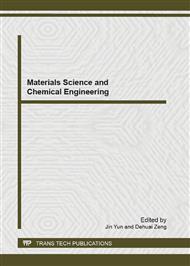[1]
A.M. Starik, N.S. Titova. Kinetics of detonation initiation in the supersonic flow of the H2+O2 (air) mixture in O2 molecule excitation by resonance laser[J]. Kinetics and Catalysis. 2003, 44 (1):28-39.
DOI: 10.1134/s0023158406030025
Google Scholar
[2]
A. Starik, N. Titova, L. Bezgin, et al. Control of Combustion by Generation of Singlet Oxygen Molecules in Electrical Discharge [J]. J. Phys. 2006, 56: 1357-1363.
DOI: 10.1007/s10582-006-0374-1
Google Scholar
[3]
V. Kozlov, A. Starik, N. Titova. Combustion Enhancement of Combustion of A Hydrogen-Air Mixture by Excitation of O2 Molecules to the a1Δg state [J]. Expl. Shock Waves, 2008, 44 (4): 371-379.
DOI: 10.1007/s10573-008-0062-5
Google Scholar
[4]
V. Smirnov, O. Stelmakh, V. Fabelinsky, et al. On the Influence of Electronically Excited Oxygen Molecules on Combustion of Hydrogen-Oxygen Mixture [J]. J. Phys. D: Appl. Phys. 2008, 41(19): 192001.
DOI: 10.1088/0022-3727/41/19/192001
Google Scholar
[5]
T. Nomaguchi, S. Koda. Spark Ignition of Methane and Methanol in Ozonized Air. Twenty Second Symposium (International) on Combustion, The Combustion Institute, Pittsburgh PA, 1988: 1677-1682.
DOI: 10.1016/s0082-0784(89)80180-8
Google Scholar
[6]
M. Gluckstein, R.Morrison, T. Khammash. Combustion with Ozone-Modification of Flame Speeds C2 Hydrocarbon-Air Mixtures[R]. University of Michigan, Reports Control No.OSR-TN-227, 1 August 1955.
Google Scholar
[7]
T. Ombrello, S. H. Won, Y. G. Ju, et al. Lifted Flame Speed Enhancement by Plasma Excitation of Oxygen[R] AIAA 2009-689.
DOI: 10.2514/6.2009-689
Google Scholar
[8]
T. Ombrello, W. Sun, S. H. Won, et al. Mechanisms of Kinetic Combustion Enhancement by O2a1Δg [R]. AIAA 2010-1586.
Google Scholar
[9]
T. Ombrello, S. H. Won, Y. G. Ju,et al. Flame propagation enhancement by plasma excitation of oxygen. Part II: Effects of O2 (a1Δg) [J]. Combustion and Flame, 2010, 157(10):1916-1928.
DOI: 10.1016/j.combustflame.2010.02.004
Google Scholar
[10]
T. Ombrello, S. H. Won, Y. G. Ju,et al. Flame propagation enhancement by plasma excitation of oxygen. Part I: Effects of O3 [J]. Combustion and Flame,2010,157(10):1906-1915.
DOI: 10.1016/j.combustflame.2010.02.005
Google Scholar
[11]
A.M. Starik, V.E. Kozlov, N.S. Titova. On the influence of singlet oxygen molecules on the speed of flame propagation in methane-air mixture [J]. Combustion and Flame, 2010, 157(2):313-327.
DOI: 10.1016/j.combustflame.2009.11.008
Google Scholar
[12]
Z H Wang, L Yang, B Li, et al. Investigation of Combustion Enhancement by Ozone Additive in CH4/Air Flames Using Direct Laminar Burning Velocity Measurements and Kinetic Simulations [J]. Combustion and Flame, 2012, 159(1): 120-129.
DOI: 10.1016/j.combustflame.2011.06.017
Google Scholar
[13]
http://www.me.berkley.edu/gri_mech/
Google Scholar
[14]
A. Y. Starikovskii. Plasma Supported Combustion [J]. Proceedings of the Combustion Institute, 2005, 30: 2405-2417.
DOI: 10.1016/j.proci.2004.08.272
Google Scholar
[15]
A.M. Starik, B.I. Lukhovitskii, N.S. Titova Mechanism of initiation of combustion in the CH4(C2H2)/Air/O3mixtures by laser excitation of the O3 molecules[J]. Kinetics and Catalysis, 2007,48 (3):348-366.
DOI: 10.1134/s0023158407030032
Google Scholar
[16]
I. Glaschick-Schimpf, W.Hans, U. Schurath .Bunsentagung. Bielefeld, Germany. 1983:84.
Google Scholar
[17]
A.M. Starik, N.S. Titova. Initiation of Combustion of a Methane–Air Mixture in a Supersonic Flow Behind a Shock Wave during Laser Excitation of O2 Molecules [J]. Technical Physics, 2004,49 (9) :1116–1125.
DOI: 10.1134/1.1800231
Google Scholar
[18]
A.M. Starik, V.E. Kozlov, N.S. Titova. On the influence of singlet oxygen molecules on the speed of flame propagation in methane-air mixture [J]. Combustion and Flame, 2010, 157(2):313-327.
DOI: 10.1016/j.combustflame.2009.11.008
Google Scholar
[19]
N.G. Dautov, A.M. Starik. On the problem of choosing a kinetic Scheme for the Homogeneous Reaction of Methane with Air [J]. Kinetics and Catalysis, 1997, 38 (2):28-39.
Google Scholar
[20]
Manual of chemkin
Google Scholar
[21]
M. Frenklach, D.E. Bornside. Shock-initiated ignition in methane-propane mixtures[J]. Combustion and Flame, 1984, 56(1):1-27.
DOI: 10.1016/0010-2180(84)90002-6
Google Scholar
[22]
A. Burcat, K.Scheller, A. Lifshiitz. Shock-tube investigation of comparative ignition delay times for C1-C5 alkanes [J]. Combustion and Flame, 1971, 16(1):29-33.
DOI: 10.1016/s0010-2180(71)80007-x
Google Scholar
[23]
A. Lifshiitz, K. Scheller, A. Burcat, et al. Shock-Tube Investigation of Ignition in Methane-Oxygen-Argon Mixtures [J]. Combustion and Flame, 1971, 16(3):311-321.
DOI: 10.1016/s0010-2180(71)80102-5
Google Scholar
[24]
C.M. Vagelopoulos, F.N. Egolfopoulos. Direct experimental determination of laminar flame speeds [J]. Proceedings of the Combustion Institute, 1998, 27: 513-519.
DOI: 10.1016/s0082-0784(98)80441-4
Google Scholar
[25]
G.J. Gibbs, H.F. Calcote. Effect of molecular structure on Burning Velocity [J].Journal of Chemical and Engineering Data,1959,4(3):226-237.
DOI: 10.1021/je60003a011
Google Scholar
[26]
Maaren A. Van, D.S. Thung, L.R.H. De Goey. Measurement of Flame Temperature and Adiabatic Burning Velocity of Methane/Air Mixtures [J]. Combustion and Flame,1994,96 (4):327-344.
DOI: 10.1080/00102209408935360
Google Scholar
[27]
H. Eberius, T. Kick, Ber. Bunsenges. Stabilization of Premixed, Conical Methane Flames at High Pressure [J]. Phys.Chem,1992,96(10):1416- 1419.
DOI: 10.1002/bbpc.19920961013
Google Scholar
[28]
J.H. Bechtel, R. Blint, C.J. Dasch, et al. Atmosphere Pressure Premixed Hydrocarbon-Air Flames:Theory and Experiment [J]. Combustion and Flame, 1981, 42(2):197-213.
DOI: 10.1016/0010-2180(81)90158-9
Google Scholar


